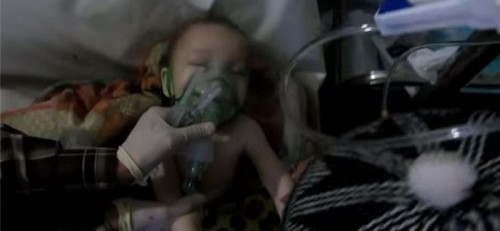PHOTO: Infant victim of regime attack on Sarmin, near Idlib, in mid-March
Human Rights Watch has issued a report that “evidence strongly suggests” that the Assad regime used chemical weapons on several occasions in March, as it tried to prevent the rebel advance across Idlib Province and into Idlib city in northwest Syria.
The report summarizes six claimed attacks near Idlib between March 16 and 31, with chlorine canisters dropped inside barrel bombs. Syrian rescue workers reported that these attacks affected at least 206 people, including 20 civil defense workers, with one strike killing six members of a family, including three children. It says three of the attacks are “strongly indicated” by witness accounts and photo and video evidence, while three others “require follow-up inquiries”.
Syrian civil defence volunteers documented 14 barrel bombs, from seven attacks in four locations, that contained apparently toxic chemicals. Human Rights Watch carefully says it “cannot conclusively establish the chemical used”, but “several witnesses described a chlorine smell”.
The report bears out accounts at the time from witnesses, civil defense workers, and medical personnel.
See Syria Video Feature: Victims of Monday’s Chlorine Attack in Idlib Province
Syria Daily, March 17: Reports — Chlorine Bombs Kill and Wound Scores in Idlib Province
Human Rights Watch calls for the UN Security Council to “respond strongly” to the latest indications of chemical attacks.
On March 6, the Council passed a resolution which “condemned in the strongest terms any use of chlorine as a weapon” and warned that it might take “Chapter VII” action, which could include further economic sanctions, if chemicals were used again.
Throughout March, the Syrian air force attacked areas near Idlib, such as Sarmin, to try and check the advance of opposition fighters. The effort failed to defend Idlib, which was taken by rebels on March 28, but the regime has continued aerial attacks to try and break up the opposition effort to establish control.
See Syria Daily, April 1: Regime Bombing After Loss of Idlib — “More Than 50 Killed”
Human Rights Watch, reviewing the claimed chemical attacks, says, “People near the impact sites exhibited symptoms consistent with exposure to toxic chemicals, and gas canisters were among the barrel bomb remnants at the impact sites.” It continues:
Three doctors who treated those exposed in two of the attacks told Human Rights Watch that symptoms included trouble breathing, burning eyes, burning sensation in the throat, and coughing. In the most serious cases, the doctors described patients suffering from pulmonary edema, or fluid in the lungs. Keith Ward, an independent expert on the detection and effects of chemical warfare agents, reviewed the clinical signs and symptoms described to Human Rights Watch and the videos of victims from two of the attacks and said they were consistent with exposure to a choking agent.
One of the specialists who tested samples from Sarmin, tweeted about the “positive” outcome for chlorine:
Samples I tested 11 Apr 15 fm Sarmin #Syria positive for #chlorine on 16 Mar 15 @annie_sparrow @hrw 6 dead 85 injured pic.twitter.com/PE9xcluJF0
— Hamish DBG (@HamishDBG) April 15, 2015

